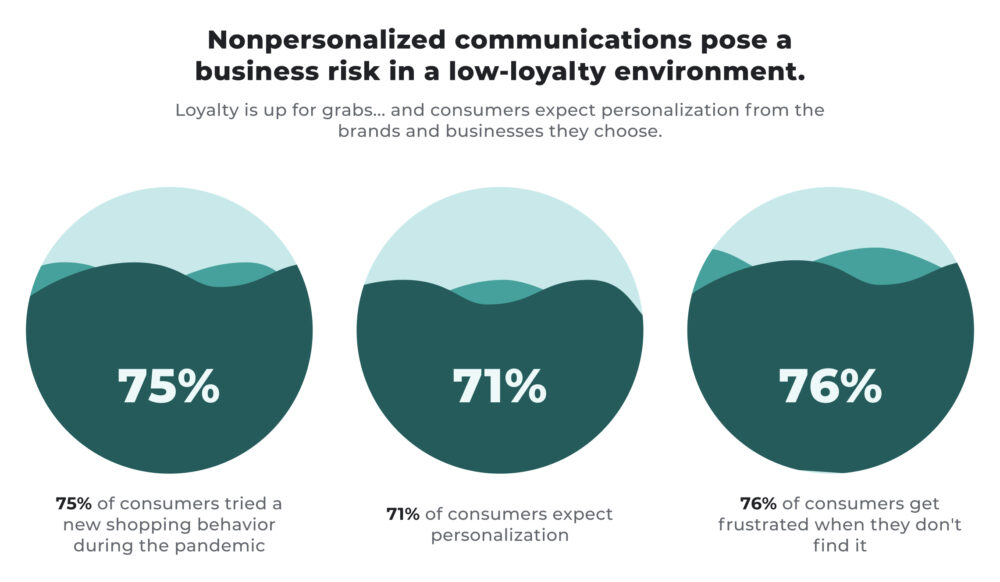From 100 to 1 Million SKUs: The Mass Personalisation Revolution on the Digital Shelf
Introduction: The Death of ‘One Size Fits All’
Here’s a statistic that should worry any e-commerce director: according to a survey by McKinsey, 71% of consumers expect personalised interactions and 76% get frustrated when they don’t. In other words, when the experience doesn’t meet their expectations, switching brands is now easier and more common than ever.
The key to winning back their attention is to understand how they search. Today’s consumer no longer browses generic categories: they filter, compare, and select based on very specific needs. They don’t search for “face cream,” but for “paraben-free cream for sensitive skin with SPF 50”.
For decades, brands operated with a single, static content model. They would create one standard description and replicate it across all channels: Amazon, Zalando, their own online shop, or specialised marketplaces. With the same text, the same specifications, and the same images. Creating distinct product detail pages (PDPs) for 10,000 different SKUs was simply unfeasible. Content marketing teams couldn’t keep up, budgets soared, and the available technology couldn’t handle that volume of personalised information. The result was predictable: generic content that tried to speak to everyone but truly connected with no one.
Source: The value of getting personalization right—or wrong—is multiplying – McKinsey, November 2021
Looking ahead to 2026, continuing with that strategy is a direct path to failure. Winning on the Digital Shelf requires adapting the content of each SKU to the channel’s context and, above all, to the specific profile of the user searching for it.The data speaks for itself: companies that adopt advanced, AI-based personalisation strategies can generate up to 40% more revenue from these initiatives. Moreover, the most mature companies in this area grow about 10 percentage points faster than their direct competitors. The better a company uses its data to know and understand its customers, the greater the impact on the business.
In this context, mass personalisation is no longer a luxury reserved for large tech corporations but has become a basic competitive necessity.
What Is SKU-Level Personalisation?
Often, when we talk about personalisation in e-commerce, our minds automatically turn to CRM strategies: emails that include the customer’s name or product recommendations based on browsing history. However, SKU-level personalisation operates on a different and much deeper layer of the shopping experience.
We’re talking about the ability to modify the structural elements of the product detail page —title, description, benefits, and image gallery—to match the expectations of the audience segment viewing that item or the nature of the channel where it is displayed.
Let’s think about a pair of high-end running trainers. The physical product is exactly the same: same sole, same upper, same cushioning technology. However, the way it is presented can and should vary radically.
When a professional marathon runner is looking for these trainers, the product detail page must prioritise specific technical data: energy return, the drop that favours a midfoot strike, the weight, or the midsole composition. The images will highlight cross-sections of the technology, close-ups of the sole, and performance graphics.
In contrast, when a user focused on street fashion is looking for the same model, the presentation changes completely. The page highlights the exclusive design, limited colour palette, collaboration with a renowned designer, and the story behind the model. Images show complete outfits, pairings with different garments, and the product in attractive urban settings.
But the product remains identical. What changes is the narrative, focus, and hierarchy of information that each type of user receives.
The Engine of Change: Attributes and Structured Data
Carrying out this personalisation manually for ten products is feasible. Doing it for thousands of SKUs is impossible without a solid data foundation. This is where product information management comes into play. Personalisation is a data game, not a creative magic trick.
The fundamental element of this strategy is the “attribute”. An attribute is any discrete piece of data that defines a product characteristic: colour, material, size, weight, country of origin, type of fastening, etc. Each of these attributes acts as a smart tag that allows the system to identify which products match each specific search.
When a user enters an online shop and selects “Jackets”, then “Waterproof”, and finally “Colour: Black”, they are interacting directly with the attributes the brand has previously defined. If a brand has an excellent jacket, with a complete and persuasive description, but has forgotten to tag the “waterproof” attribute in the database, that product will be invisible to the user applying that filter. The quality of the text becomes irrelevant if the product doesn’t appear in the search results.
A critical example can be found in the food and cosmetics sector. Imagine a consumer searching for vegan products. If the product page doesn’t have the “vegan” attribute explicitly marked and structured (not just mentioned in a paragraph of text, but tagged in the corresponding system field), the marketplace’s algorithm won’t be able to index it correctly for that specific search.
Therefore, before thinking about generating creative copy automatically, companies must audit and clean their structured data. The granularity of the attributes determines the capacity for personalisation. The more specific details a product has broken down into data, the greater the potential for creating precise and relevant shopping experiences.
How to Scale: The Role of Generative AI
The main historical obstacle to mass personalisation was simply impossible to solve with traditional methods: how do you create and maintain personalised content for tens or hundreds of thousands of SKUs, multiplied by different channels, languages, and audience segments? A quick calculation: 10,000 products × 5 channels × 3 audience variants × 4 languages = 600,000 different content versions. Impossible to manage with human copywriters.
This is where Generative Artificial Intelligence becomes the indispensable operational tool. It allows a shift from a manual copywriting model to an editorial supervision model, multiplying content production capacity.
Let’s see how it’s applied in four key areas:
1. Advanced translation and localisation
AI platforms can translate product descriptions into multiple languages, but they go far beyond literal translation. Generative AI enables “transcreation” processes at scale.
They adapt idiomatic expressions, adjust cultural references, and respect market-specific regulatory standards. A description for a food supplement must comply with very different regulations in Spain, Germany, or the United States, and these platforms can automate those adjustments.
2. Attribute enrichment
One of the most powerful applications of current technology is the ability to extract information from images. Suppose a fashion brand receives 1,000 photographs of its new collection, but the textual information is scarce. AI tools can analyse the pixels in each image and automatically detect features: “long sleeve”, “V-neck”, “floral print”, “coral red”. This data is automatically converted into structured attributes in the management system (PIM), saving thousands of hours of manual data entry and reducing human error.
3. Adapting the tone of voice
Each sales channel has its own language. Amazon rewards brevity, feature lists, and keyword density. In contrast, a luxury brand’s own online shop or a social network like Instagram requires an aspirational, evocative, and emotional tone.
Generative AI makes it possible to take a product’s technical attributes (e.g., “organic cotton”, “made in Portugal”) and generate multiple versions of the description. One version will be technical and optimised for SEO on marketplaces; another will be narrative and enticing for the corporate website. The system can rewrite thousands of product pages in minutes to adapt them to each channel’s style guide, maintaining brand consistency while adjusting the linguistic register.
4. Available technological solutions
The market already offers mature solutions for implementing mass personalisation. Product Information Management (PIM) platforms like Akeneo, Salsify, or inRiver integrate AI capabilities to enrich, translate, and adapt content. Other specialised tools focus specifically on generating optimised product descriptions.
Many of these platforms allow you to define templates with rules: “For products in category X, when the user comes from channel Y and belongs to segment Z, prioritise these attributes and use this tone”. The system applies these rules automatically to thousands of SKUs simultaneously.
The important thing to understand is that these tools do not replace human judgement. They require supervision, adjustments, and validation. But they drastically reduce the time and cost of creating personalised content on an industrial scale.
KPIs and Measuring Success
Implementing mass personalisation requires investment and a profound cultural shift. And, like any serious business initiative, it also needs clear metrics to evaluate its effectiveness. It’s not enough to deploy technology and assume it works: it is essential to measure, compare, and optimise continuously.
Attribute completeness
This is a catalogue health indicator. It measures the percentage of data fields that are filled in for each SKU. A product with 100% completeness is much more likely to appear in filtered searches than one with 60%.
Conversion rate per SKU
By personalising the content, we should see an increase in conversion. If we adapt the page for a technical product to an expert audience, the clarity of the information should reduce friction and increase sales.
Share of shelf
This indicates what percentage of relevant searches in your category your brand captures. If you sell coffee machines and there are 10,000 monthly searches for “automatic espresso machine”, how many of them do you appear on the first page for? This metric reveals your real visibility on the Digital Shelf.
Returns and quality signals
This metric is fundamental and often overlooked. A precise and detailed product description aligns customer expectations with the reality of the item. If AI helps us to better detail sizes or materials, we should see a reduction in returns for reasons like “the product was not as expected” or “inaccurate description“.
A/B testing
The ability to generate content quickly allows for hypothesis testing. We can launch two versions of a title or a main image for the same product over a controlled period and measure which one generates more clicks and sales, optimising the catalogue based on real behavioural data.
Personalised recommendations alone account for almost a third of e-commerce revenue, and sessions adapted to user behaviour can more than triple the average order value. This is possible because AI detects patterns and purchasing signals that a human analyst would take months to discover, making it possible to create highly relevant experiences instead of generic messages.
Challenges: Data Quality, Privacy, and Consistency
Despite the clear advantages, adopting this technology comes with significant challenges that organisations must manage prudently.
The first obstacle is the quality of the source data. AI algorithms work on the premise that they learn from and operate on the information they are given. If the product database contains errors, duplicates, or outdated information, the AI will scale those errors at breakneck speed. Cleaning and normalising master data is an unavoidable preliminary step.
Another significant challenge is brand consistency. When generating thousands of automatic descriptions, there is a risk that the brand’s tone of voice becomes diluted or robotic. Human supervision is still necessary to audit random samples of the generated content and ensure the brand’s “personality” remains present, even when the text has been written by a machine.
There is also a risk of creating “content bubbles” where the user only sees products and descriptions that reinforce their previous preferences, limiting their ability to discover alternative options. An overly aggressive personalisation algorithm can reduce the diversity of exposure and impoverish the shopping experience.
Finally, although product personalisation touches on less personal data than marketing personalisation, there are ethical and legal implications. If we use a user’s browsing data to dynamically show them a version of the product page, we must be transparent about the use of cookies and respect privacy regulations like GDPR. The user must feel that the personalisation adds value and is useful, not that they are being watched.
Conclusion: The Atomisation of Content
The future of content on the Digital Shelf is heading towards what we might call the “atomisation of content“. Instead of thinking of a product page as a monolithic block of information, we must see it as a collection of content atoms: discrete fragments of information (attributes, benefits, specifications, visual elements) that can be dynamically recombined according to the context.
Imagine that each feature of your product is an individual atom stored in your database: “Material: certified organic cotton”, “Benefit: regulates body temperature”, “Recommended use: low-intensity outdoor activities”, “Environmental impact: carbon footprint offset”. Each one is a piece of verified information, translated into multiple languages and tagged with metadata about when and how to use it.
When a specific user on a particular channel searches for your product, the system selects and combines the most relevant atoms for that context. It reassembles the information in real time, generating a product page perfectly adapted to that particular situation. Content is no longer static; it is fluid and contextual.
The brands that succeed in breaking down their information into these atoms and using artificial intelligence to reassemble them according to the exact needs of the customer at any given moment will be the ones to dominate the market. They will be able to be present in a relevant way on hundreds of channels simultaneously, speak to each audience segment in its own language, adapt messages to emerging trends in days instead of months, and scale international operations without proportional increases in cost.
The question is no longer whether or not to implement mass SKU-level personalisation, but how long you can afford to wait while your competition does it first. The 2026 Digital Shelf will reward those who understand that every product, in every context, deserves to have its own perfectly tailored story.







